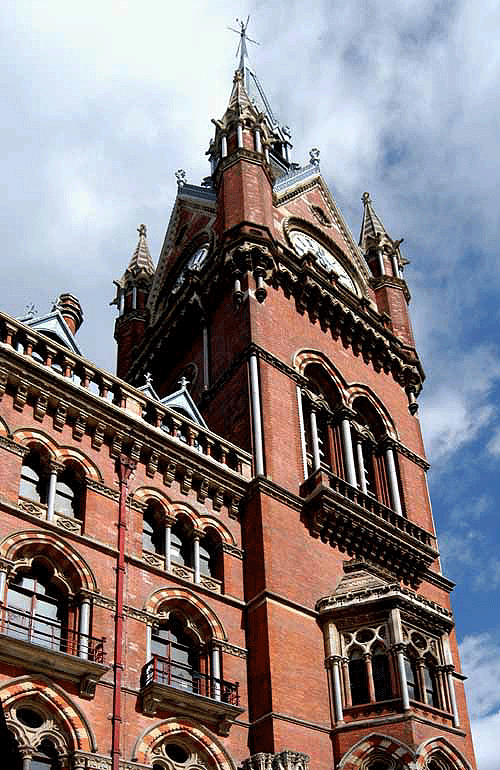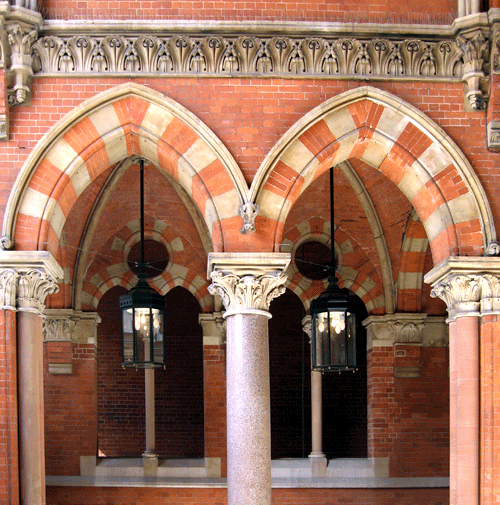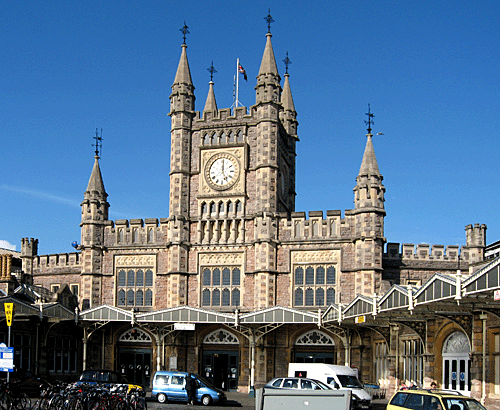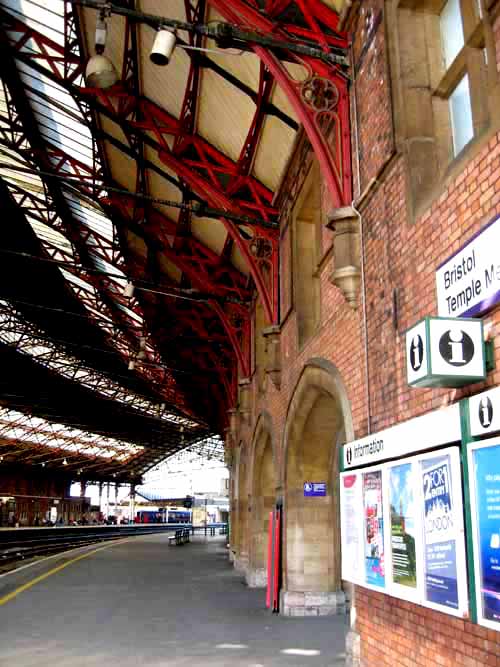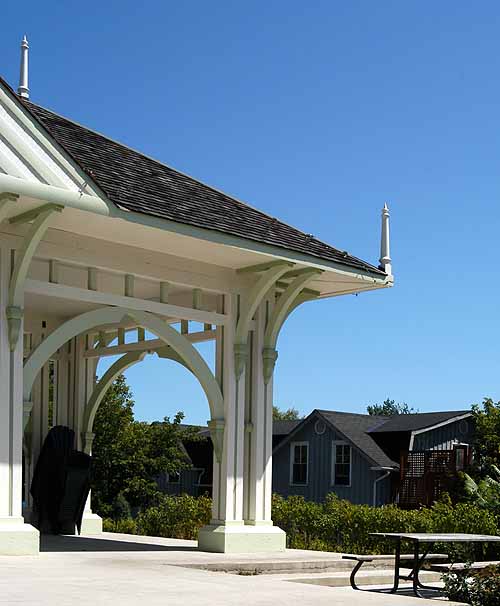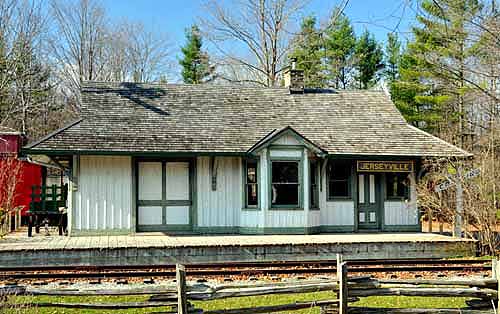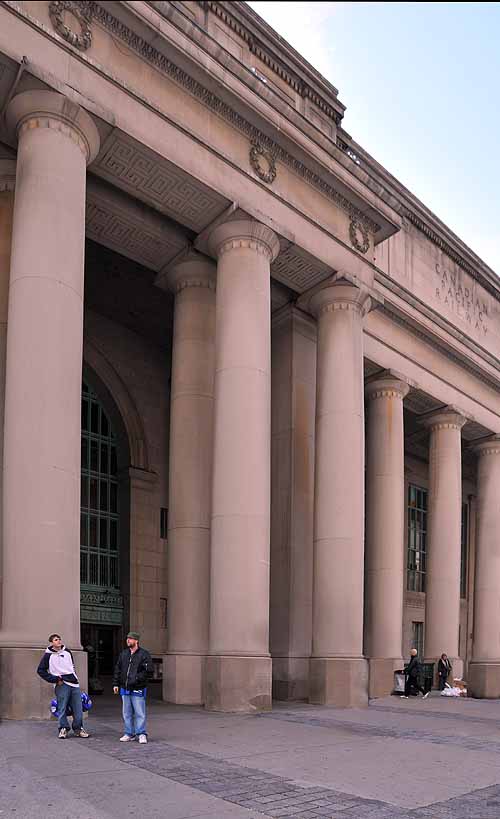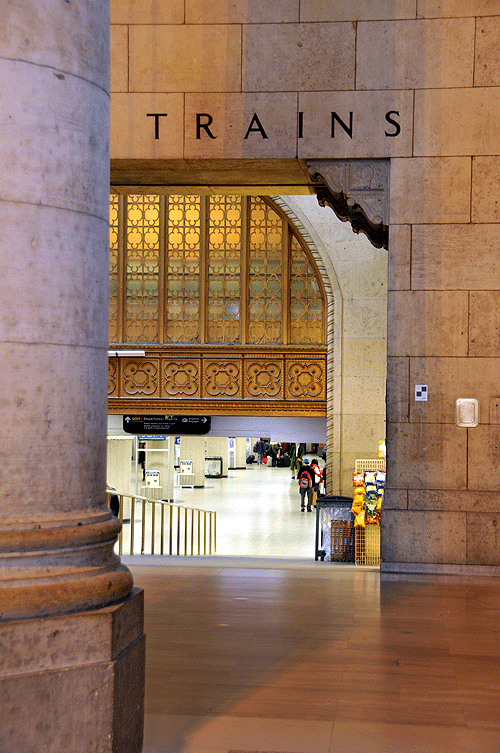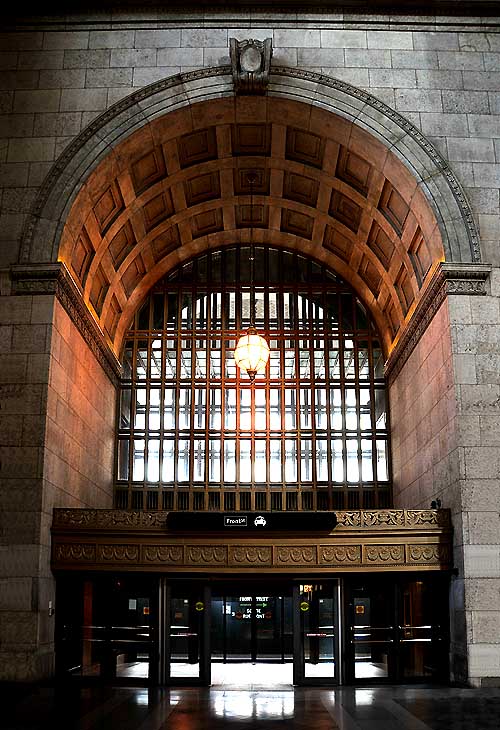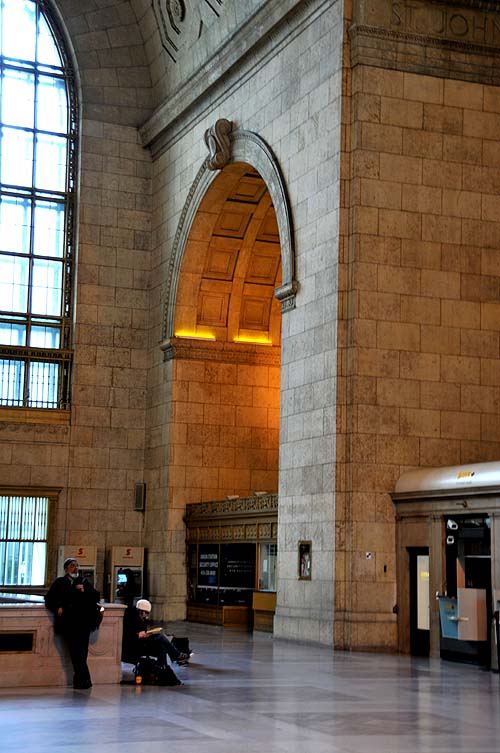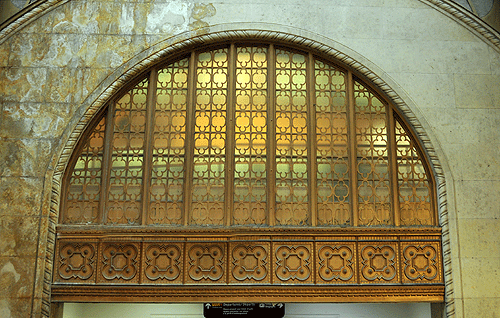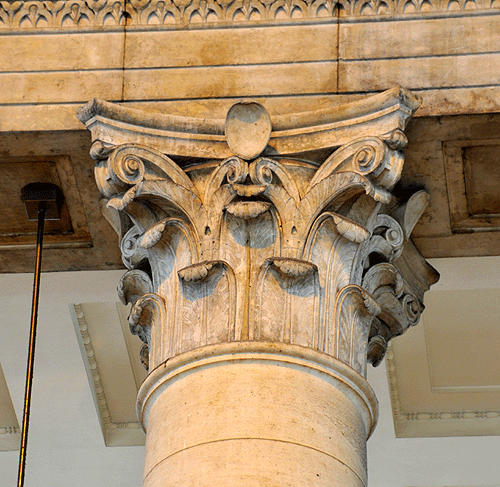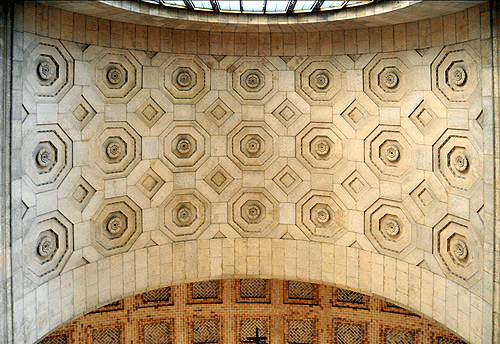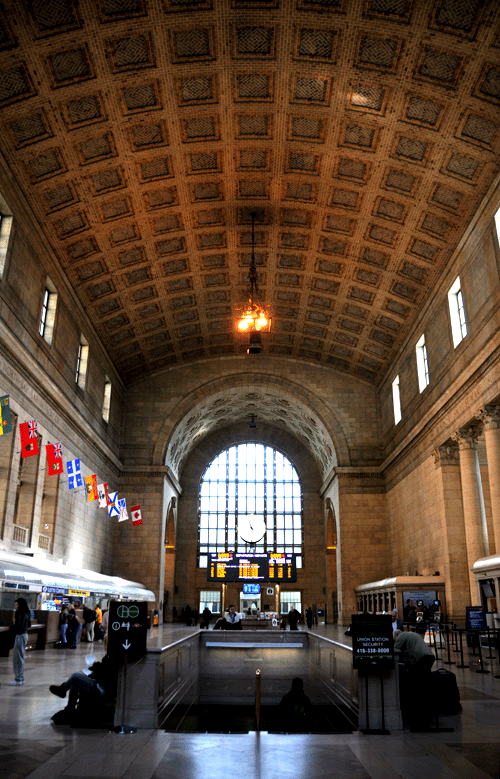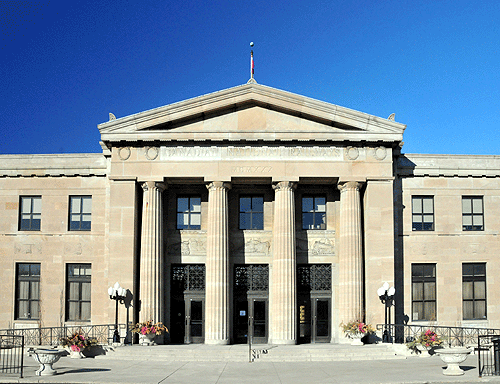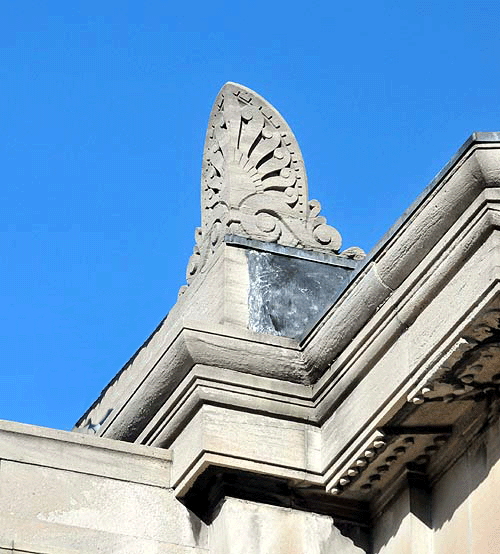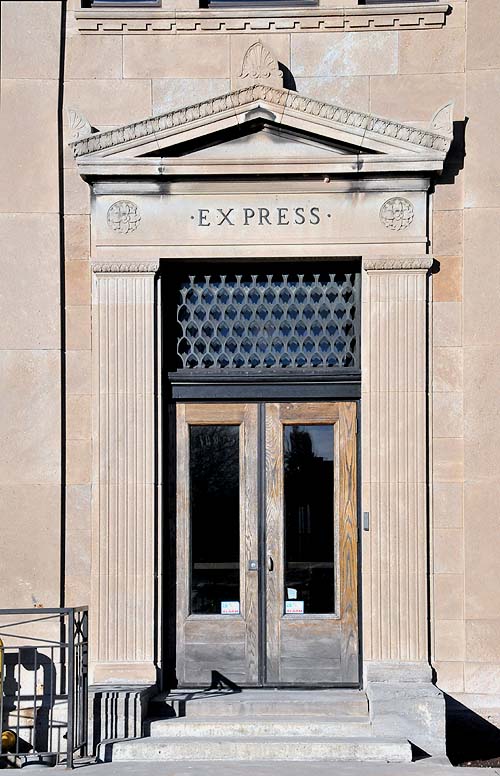|
St.
Pancras
St. Pancras Station in London
serviced the Midlands and perhaps more importantly, provided
20 percent of London's coal and a great deal of London's beer.
A brewery was found on the basement level of the station.
George Gilbert Scott was chosen
as the designer because his was the most impressive façade.
His was also the most expensive at , £315,000 but the
Midland Railway directors were interested in getting an impressive
railway station before the second huge International Exhibition
in London in 1862.
|
|
|
St. Pancras Station
St. Pancras Station has some
of the best examples of Victorian Gothic brickwork in the world.
Here we have a set of paired lancet arches done in dichromatic
brickwork for the voussoirs. The capitals are Late/Gothic Renaissance
floral patterns with a large abacus. The column shafts are marble.
In the background are trefoil
arches with impressive impost blocks.
|
|
|
I.
K. Brunel
Temple Meads Railway Station, Bristol 1840
While the platforms and public areas in the interior
of the station are revolutionary in their use of space and materials,
the exterior resembles a castle with turrets, castellation,
iron cresting, and many traditional civic medieval details.
|
|
|
I. K. Brunel
Temple Meads Railway Station, Bristol 1840
While the exterior of the Temple Meads Railway
Station in Bristol resembles a medieval castle from the exterior,
the materials used to build it and the platforms themselves
are radically different from anything done before.
The main railway building is brick with stone
detailing.
This is then attached by cast iron ribs to iron
joists along the ceiling. Between the joists is glass.
The detailing of the stone and brickwork is medieval.
|
|
|
Eastern
Ontario: Ottawa to Oshawa
|
The largest center east of Toronto is and has
been for almost a century, Ottawa. Like Toronto they had
a magnificent Beaux Arts train station right in the middle
of the city. Politicians being what they are, decisions
were made in the 1960s that placed the train station outside
of town and all the tracks were taken out. At least the
building was not ruined.
|
|
All across the eastern side of Ontario small
towns were united by a web of train lines that allowed farmers
and rural dwellers access to other markets and larger city
centers. Now many of these tracks have been abandoned and
pulled up. At least the train line clearings can now be
used for cycling and cross country skiing.
|
|
|
Ottawa
A stunning Beaux Arts train station equaling the
grandeur of Toronto's Union Station sits in the middle of downtown
Ottawa. A couple of good blogs will explain why it is now used
as a convention center.
It is still a stunning building with Tuscan columns,
an impressive attic story and a wonderful marquee.
|
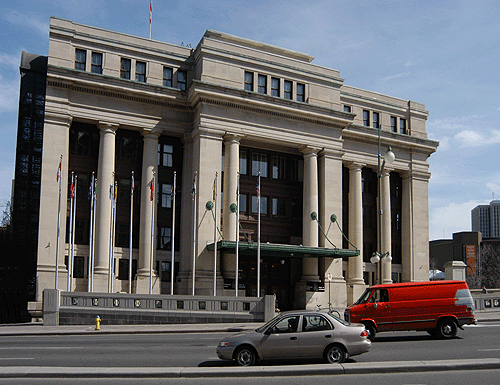
Ottawa Ontario
|
|
Chateau Laurier
As the railways connected the various urban centers
across Canada, a series of gorgeous hotels was build by Canadian
Pacific Rail company.
Château Frontenac in Montreal, Chateau Laurier
shown here, Chateau Lake Louise in Lake Louise are just a few
of the first class hotels constructed in the Chateau style.
|
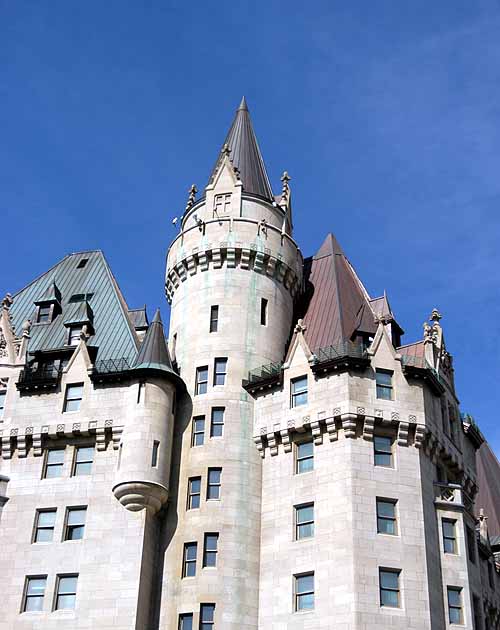
Ottawa Ontario
|
|
Central
Ontario
|
Large city centers such as Toronto and Hamilton
had impressive buildings done in the European revival styles.
Smaller train stations were done with vernacular materials
and craftsmen. The carpenters used exaggerated bracing and
lamb's tongue brackets to support the necessarily large
overhangs. Roofs were low and unprepossessing.
|
|
Many Ontario towns have noted the value of their
historic train stations. While many are no longer in use
as train stations, people have bought them and turned them
into restaurants or gazebos, or they are part of parks and
community centers.
|
|
|
Markham
The Markham train station was a Victorian beauty.
It has been completely restored and is now used as a gazebo
in a public setting.
|
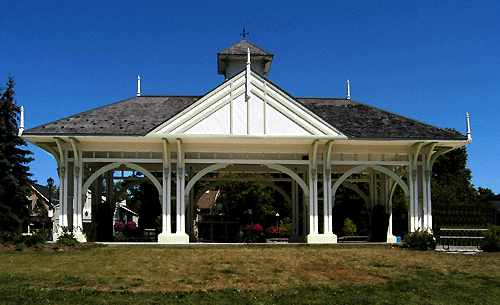
Markham Ontario
|
|
Detail
of Brackets and Columns Markham
Anyone who loves wood working will love this detail
of the brackets and finials.
|
|
|
Jerseyville
Train Station
The Jerseyville train station was perhaps the
first of the disappearing train stations to be rescued. Two
retired teachers thought it was worth preserving, so they had
it dismantled, bought some land just west of Hamilton, and reconstructed
it. This building was the first building in a reconstructed
19th century town called Westfield
Village. If you are interested in Ontario's heritage architecture,
the knowledgeable staff and volunteers at Westfield have made
a startlingly good complete town that offers many seasonal attractions
and festivities as well as the perfect setting for a wedding
or other grand event.
|
|
|
Union
Station Toronto
Union Station is one of the best preserved Beaux
Arts buildings in Canada having just been restored to it's original
glory. John Lyle designed this building after studying the Baths
of Caracalla.
|
|
|
Union
Station Interior
The interior is a wonderful mixture of Roman stone
columns and barrel vaults with Art Nouveau style metal grills.
|
|
|
Union
Station Doorway
You can't help but feel overwhelmed at the grandeur
of the station walking through the massive barrel vaulted doorways.
|
|
|
Stone,
Glass and Brass
Every detail of the building is coordinated and
fits perfectly. You can wonder why the building housing the
newest and most revolutionary technology to date - the train
- was housed in a building fashioned after a 2000 year old bath
house, but you can't say it isn't gorgeous.
|
|
|
Union
Station Toronto
An ornate metal grille housed within a Roman arch
seems somehow normal under the circumstances.
|
|
|
Union
Station Toronto
True to Roman form, the column capitals are Tuscan
outside the building and Corinthian within.
|
|
|
Union
Station
Octagonal coffers frame the opening for the windows.
|
|
|
Union
Station coffers
Clerestory windows help to illuminate the coffers
in the barrel vault which spans the length of the building.
|
|
|
Liuna
Station Hamilton
Now a banquet center, this grand facade was the
next stop on the TH&B line - Toronto, Hamilton ad Buffalo.
It has also been used in a wide variety of movies.
|
|
|
Acroterion
Liuna Station
Acroterions are found on the corners of the aedicules
in the Acropolis. Here they decorate the front facade of the
train station.
|
|
|
Aedicule
Liuna Station
An aedicule is a door surround
or window surround done in the Classical manner with engaged
columns or pilasters, an entablature, and a pediment. Again
we look to the Acropolis in Athens for inspiration on proportions
and detailing. Here the frieze states the purpose of the door
- access to the Express lines.
|
|
|
Bas relief Liuna Station
Liuna Station, like the old Post office building
in Hamilton, is known for its remarkable bas relief.
|

Hamilton Ontario
|
|
Bas Relief
The theme is travel, trains, boats, planes and
automobiles.
|
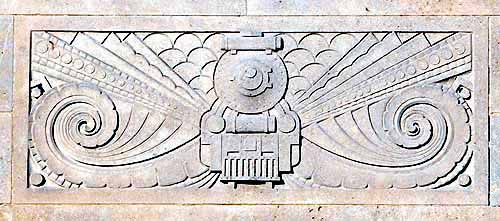
Hamilton Ontario
|
|
Guelph
The Guelph station is one of many fine Arts and
crafts style stations. Done in vernacular brick with a tall
central tower, this station is inviting and solid. The lamb's
tongue brackets under the soffits are extraordinary.
|
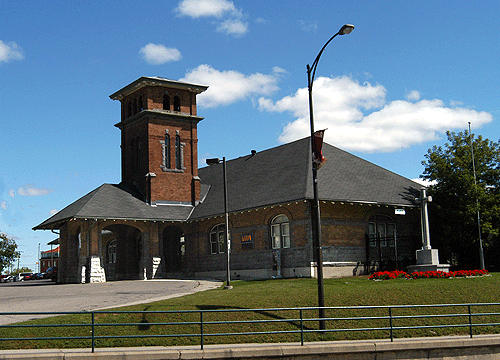
Guelph Ontario
|
|
Hamilton
Go Center
Here
is a rare example of a restored late Art Deco train station.
The counters, wall finishes, tilework, even the bathrooms are
true to the original. Hamilton really got it right this time.
|
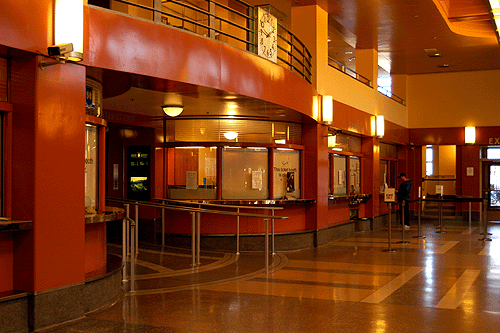
Hamilton Ontario
|
|
Hamilton GO Terminal
The sleek lines and wonderful sweeping corners
of this building are classic Art Deco.
|
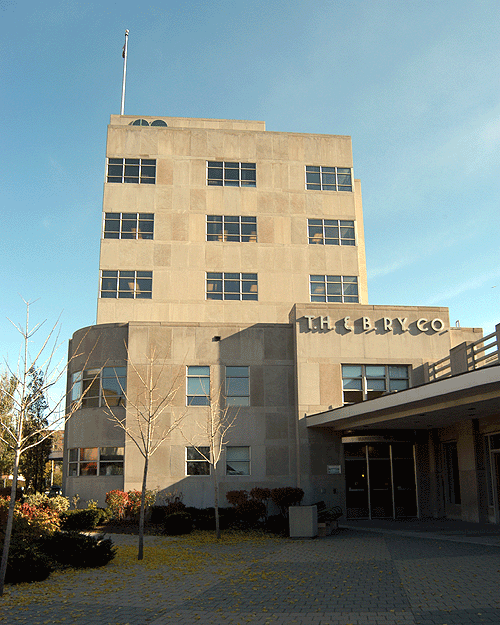
GO Station Hamilton
|
|
Hamilton GO Station
The chrome wings holding up the rod on the top
of the building are a wonderful accent to the clean ashlar finish
of the north facade.
|
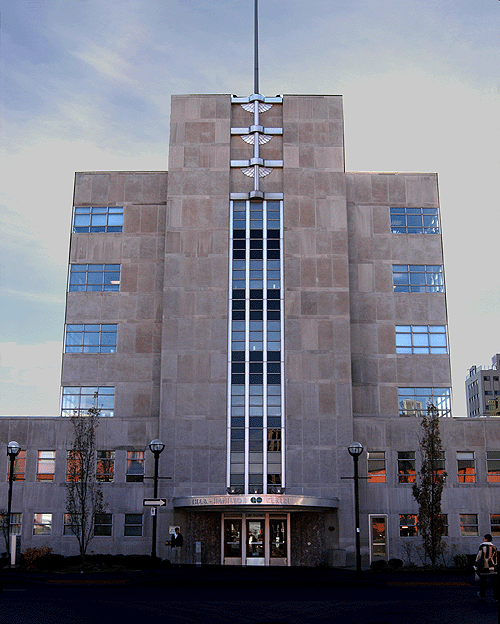
HamiltonOntario
|
|
Hamilton GO Station
These benches are all new but they are built with
an Art Deco sensibility.
|
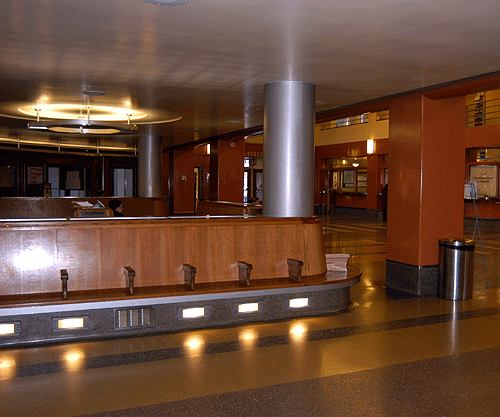
Hamilton Ontario
|
|
Train
Stations in Western Ontario
|
Heading across western Ontario the trains were
used to bring lumber and wheat from the prairies and forests
of Northern Ontario.
|
|
As communities grew, trains became more stylish.
|
|
|
Brantford
Definitely one of the finest Arts and Crafts train
stations in the world, the brantford train station is as much
of a gem as the city itself.
|
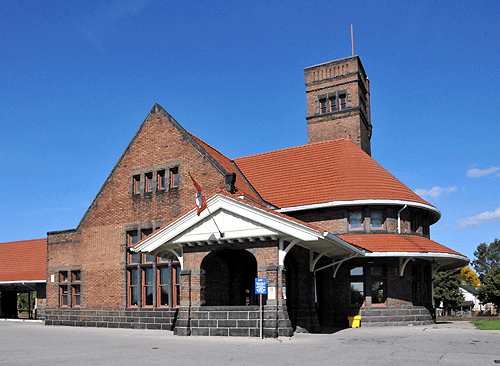
Brantford Ontario
|
|
Brantford
An oversized portico allows people to disembark
from carriages and later cars without getting wet.
|
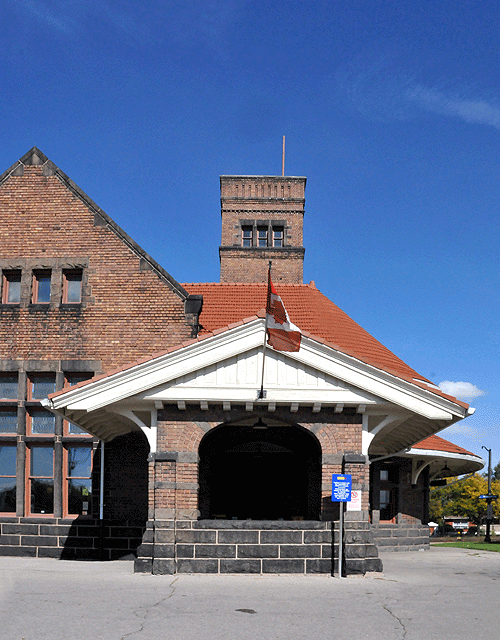
Brantford Ontario
|
|
Brantford
The tall tower is a useful addition for communication
between stations. The roofline underneath is stunning.
|
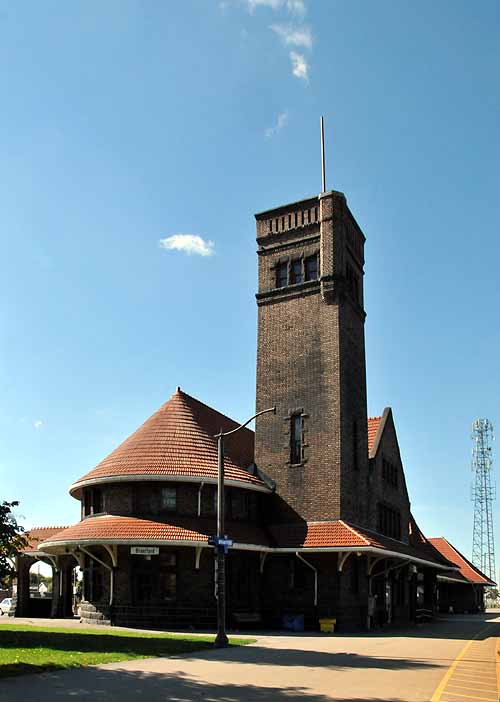
Brantford Ontario
|
|
Brantford
Impeccable
craftsmanship was standard in all the train stations. For those
who have done any wood working, imagine putting in the curving
tongue and groove soffits.
|
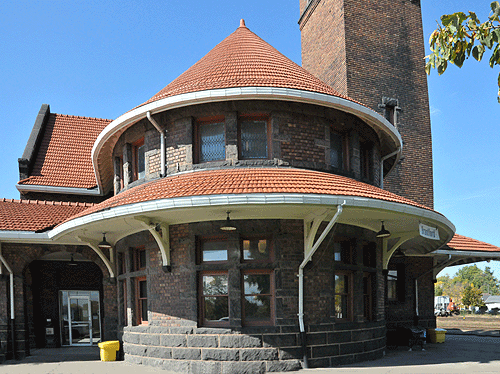
Brantford Ontario
|
|
Galt
Galt is also known as one of the best Arts and
Crafts train stations.
|
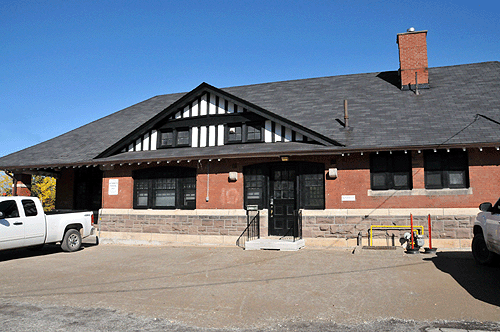
Galt Ontario
|
|
Galt
Lamb's tongue brackets support the overhang. Rafters
are open with tongue and groove finish on the underside of the
roof overhang.
|
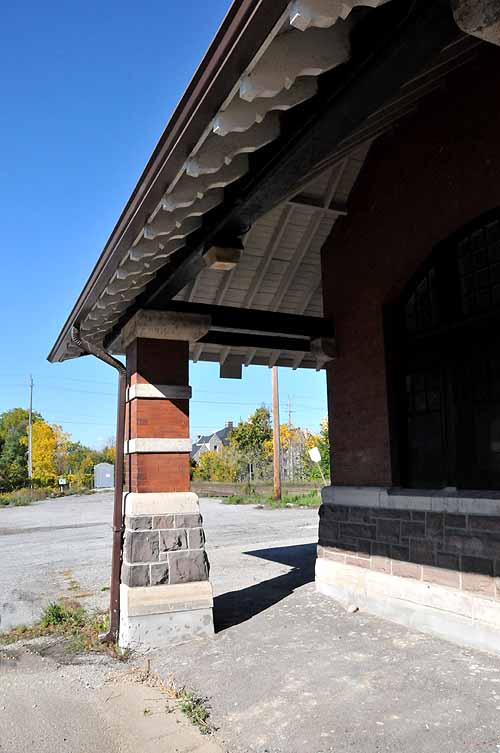
Brantford Ontario
|
|
Galt Rafter Detail
Notice how the rafters are embedded in the brick.
|

Galt Ontario
|
|
Galt
The
door surround is also unique.
|
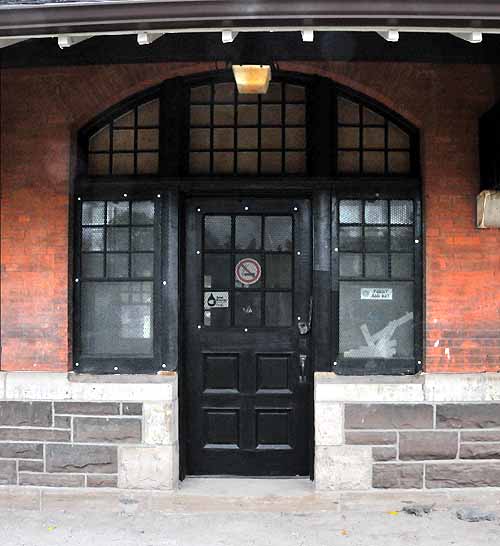
Galt Ontario
|
|
Northern
Ontario
|
Many train stations in the north are being shut
down due to underuse. Sadly this was the only link that
some people had with distant family and friends.
|
|
|
|
|
Thunder
Bay
Hundreds of miles west of most of the other settlements,
Thunder Bay was the connecting point for goods from the Prairie
provinces and markets in the east. The economic surge of the
late 19th early twentieth century led to wonderful residences
as well as this impressive and very large At=arts and Crafts
Train Station.
|
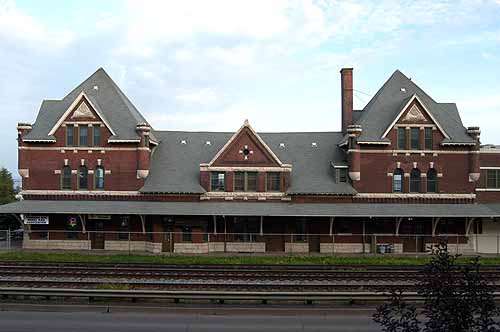
Thunder Bay Ontario
|
|
Thunder Bay
Built in 1905 by the CNR, this lovely gable end
has a crest in the inset gable, two tourelles made in the medieval
manner.
|
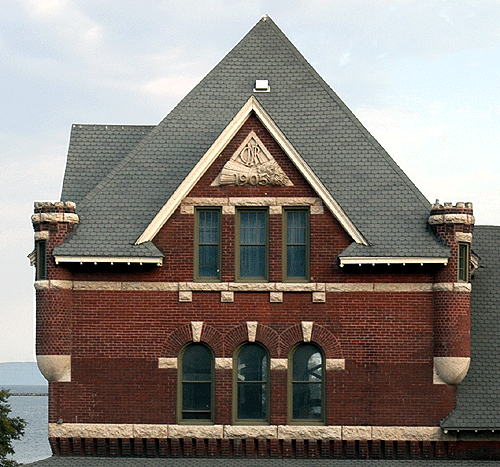
Thunder Bay Ontario
|
|
Temagami
Another Arts and Crafts gem, this has a central
half timbered bay within a rustic river stone building.
|
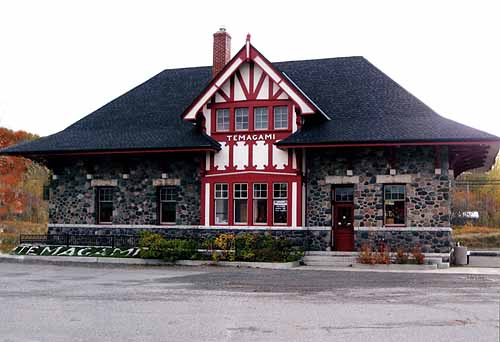
Temagami Ontario
|
|
South
Hampton
The South HAmpton station was used for a few years
as a restaurant. It is also constructed in the Arts and Crafts
style.
|
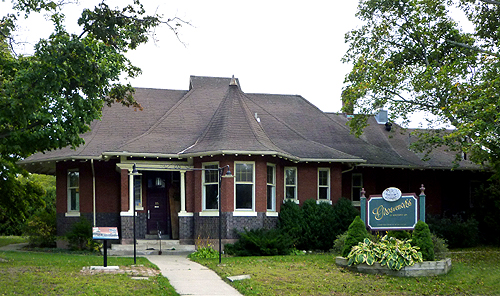
South Hampton Ontario
|
|
South Hampton
Notice the lamb's tongue brackets and generous
eaves similar to Brantford and Guelph.
|
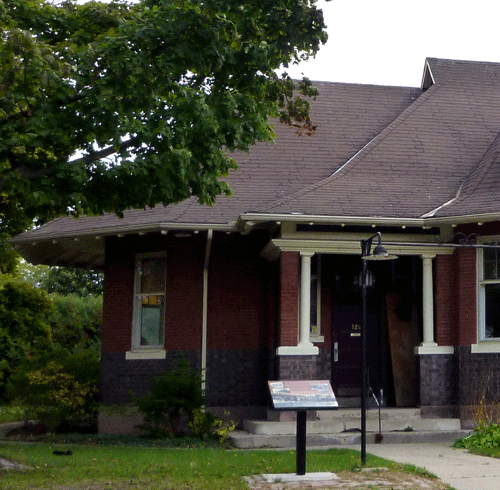
South Hampton Ontario
|
|
The
Webmistress - shannon@ontarioarchitecture.com
|
|
|
|
|
Trains
Extra Reading and Films
|
Books
Blumenson, John. Ontario
Architecture A Guide to Styles and Terms.
1978
Cruickshank, Tom, and John de Visser,
Old Toronto Houses,Toronto: Firefly Books,
2003.
Cruickshank, Tom, and John de Visser,
Old
Ontario Houses,Toronto: Firefly Books,
2000.
MacRae, Marion,
and Anthony Adamson. The
Ancestral Roof: Domestic Architecture of Upper Canada.
Toronto: Clarke, Irwin, 1963.
For information on Gothic Revival architecture
in specific areas within Ontario there are some very
good books listed under the About page.
|
|
Films
It Happened One
Night - Clark Gable, Collette Colbert
Strangers on a Train
-
Murder on the Orient
Express ,
Cranford
Trains, Planes and
Automobiles , (1995) (2008)
|
|
|

